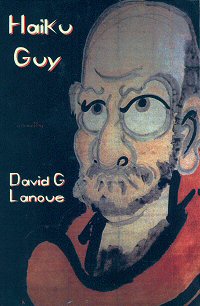
haiku
home
haiku
magazines
haiku
books
monthly
kukai
haiku
contests
renku
begin
haiku
haiku
log
That didn't work so well, so let me explain it to you another way. Haiku Guy is the story of two writers learning their way about their craft. One of them is a young peasant in 17th century Japan, who has been accepted as the student of Issa. The fact that Mr. Lanoue chooses to translate Issa's name literally, "Cup of Tea" throughout the book is paired nicely with the fact that the student's name is "Buck Teeth". The other writer is David himself, who is honing his craft by meeting with a Writing Group in a coffeehouse in New Orleans. Its hard to tell if this book is primarily a novel (which it is), or an instructional book about haiku (which it is). The reading of the first chapters of the book to David's writing group is itself the content of chapter three! "You, too, should form a writing group as soon as possible," advises our author. "Haiku is a social activity, like sex or bridge or singing karaoke songs at Happy Hour in a Bourbon Street pub." But his writing group turns out to be far more than a means by which the story is delivered. Just as the lines between novel and instructional book are blurred, the lines between the story David is writing, and the autobiographical passages about his writing group are also blurred. Just when the reader thinks he understands the dual nature of the book, the writing group: Melanie, Micky, and Chaz the scifi/horror author, all show up to meet Buck Teeth at Lord Kaga's fireworks display! Sometimes the haiku lessons come from David's world, such as when Sister Agoniste, the drill sergeant crosswalk guard nun, shouts "Stop, look, and listen, children!" Good advice for all haiku poets, we are assured. Sometimes they come from Buck Teeth's world, where well-intentioned poets are quick to give advice, but the true lessons come from other sources. Most of Buck Teeth's questions to Cup of Tea are met with long periods of silence followed by the recitation of haiku, such as:
We try so hard to study haiku as an academic subject. The portrayal of the learning process, as imagined by Dr. Lanoue, will have you laughing as you improve your poetry and realize haiku need not be taken so seriously!
Haiku Guy, by David G. Lanoue, 2000. 153 pages.
Red Moon Press.
_-_
This book may be ordered directly from the author's website, at: haikuguy.com or by using the convenient PayPal-enabled Red Moon Press order form. |
